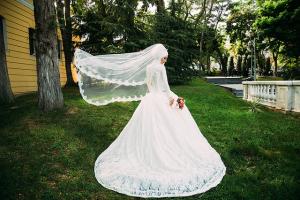During our Christmas vacation, we attended a Catholic church where a noticeable number of women were wearing chapel veils. The reasons for this practice are, I think, misguided.
Scanning the literature on this topic, I found several defenses of women wearing a veil or mantilla. They claim that it is not a misogynistic practice, and pious excuses are given, but the arguments are full of holes.
Modesty, Humility, and Modeling Mary
Advocates say that wearing a veil is a symbol of a woman’s modesty and humility; it is a sign of reverence and piety while in the presence of God. Nowhere did anyone explain why the veil represents those virtues or why only women should pursue them.
Don’t men want to be modest, humble, reverent and pious too? To complete this line of reasoning, Catholic men should wear veils or turbans or yarmulkes to show they are striving to be good as well.

It is said that wearing a veil is a way of emulating Mary. Couldn’t we just wear a Miraculous Medal, not clothing from the first century? What about the rest of Mary’s garments? Perhaps we should wear burkas like the Muslim women. Anybody in favor of that?
It is true that women have been wearing some kind of head covering in church throughout Christian history. However, for a long time that head covering (adornment) was hats, and there was seldom anything humble about those millinery confections!
Our Crowning Glory vs. God’s Glory
The reason I have most often heard on this topic is that women must wear a head covering in church because their hair is their crowning glory and only God’s glory should be evident in church. Really? Our hair is our crowning glory?
Doesn’t say much about the rest of our contributions, does it? Such a concept is obviously male because, as studies have shown, the male point of view considers women’s physical attributes almost exclusively. Our language reveals that women are described by their body parts, not their intellect, not their spirituality.
The result is that the male decision makers, who were/are easily distracted by anything female, thought women needed to cover their hair, not to humble themselves before God, but to lessen the occasion of lust among men.
This practice is not just ancient tradition that has lingered past its time. A recent article in a prominent Catholic publication still proclaimed that a woman should veil her beauty in church so that God’s beauty would be glorified instead.
Honestly, does anyone think that a woman’s hair, or anything else on earth, can compete with God’s glory? I doubt God worries about it, but apparently the dominant male society does.
Life-Bearing Princesses
One tale I hadn’t heard before researching for this blog is that a woman should be veiled like the tabernacle or the chalice because all are life-bearing vessels, all are holy and sacred.
Oh, would that this attitude was demonstrated in reality! A Mexican man once told me that he was taught to respect women since they give us life (that fails to explain machismo though). A lot of the world’s problem would be solved if women were treated respectfully, and their life-giving capabilities honored.

However, after communion, both women and men are carrying the body of Christ, so should men quickly put on a veil to show that they too contain Our Lord?
Another notion is that women are daughters of a King, so we should wear a crown-like veil because somehow that would please God. This idea probably appeals to all those who dream of being a Disney princess, but what about men as sons of a King? Where’s their crown?
Bridal Submission
Still another explanation concerns the relationship of God with His Church, which is likened to the covenant of a bridegroom to his bride. Since women are brides, the wearing of a (wedding) veil is meant to symbolize the submission of the Church to the rule of Christ.
Oh, there we have it. It is all about submission after all. Hide quietly beneath that veil, pretty girl, and let the men interpret Scripture and create “traditions” as fits their world view. Sadly, some women hear “beauty” and “bride” and think it is an elevating compliment instead of manipulative flattery.
Admittedly, some women wear a veil just because they think it is pretty or convenient for a bad hair day. Others use it like blinders to help them focus on their prayers, and that is somewhat admirable.
Otherwise, each of these reasons for wearing a veil is a projection onto women of paternalistic assumptions. So does a veil represent anything real and true about women? Maybe women should design their own symbolic practices.












